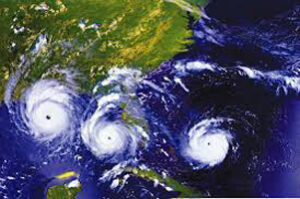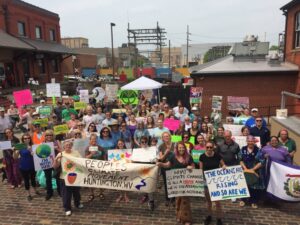Since the New Green Deal has been released, almost all of the criticisms have been aimed at the costs.
We are being told we just cannot afford this. Really? We cannot afford to take steps to save our planet and prevent our economy from suffering enormous losses as a result of climate change?
We certainly have money when it comes to military defense. The 2019 budget is $686.1 billion, with $22 billion going to nine new nuclear subs. The U.S. spends more on its military than the next seven countries combined, including China and Russia. We are running 800 military bases in 80 countries. Yet, according to the National Priorities Project, much of the money “ends up in the pockets of corporate executives,” not our troops or our veterans.
A study done by Transactions of the Institute of British Geographers with data obtained from Freedom of Information requests found that “in 2017, the US military bought about 269,230 barrels of oil a day and emitted more than 25,000,000 tons of carbon dioxide by burning those fuels. The US Air Force purchased $4.9 billion worth of fuel, and the navy $2.8 billion, followed by the army at $947 million and the Marines at $36 million.”
The military hasn’t turned a blind eye to its contribution to climate change. “Senior officials have identified three main pathways by which climate change is likely to endanger American security: by increasing the level of conflict and chaos abroad; by exposing the homeland to ever more destructive climate effects; and by obstructing the military’s capacity to carry out its assigned missions.”
This past spring, the U.S. Air Force applied for over $5 billion to repair two bases; the Tyndall Air Force Base in Panama, Florida, which was hit by Hurricane Michael, and Nebraska’s Offutt Air Force Base which was affected by extreme flooding. My late father-in-law worked at Offutt while in the air force. Both of these bases play a significant role in their local economies.
The 2019 Department of Defense report “Report on Effects of a Changing Climate to the Department of Defense,” said bases and installations face five weather/climate impacts: flooding, drought, desertification, wildfires, and melting permafrost. They looked at 79 priority installations which included the Army, Air Force, and Navy and said: 53 of these faced current threats from flooding; 43 faced threats from drought; and 36 faced threats from wildfires.
The threat from climate change to our military bases isn’t just a financial one. A recent report from Inside Climate News tells the story of an Iraq combat veteran who died as a result of extreme heat while training in 93-degree heat at Fort Chaffee Arkansas in 2016. He was not alone. “At least 17 troops have died due to heat exposure during training exercises at U.S. military bases since 2008.” Since that date 1,766 cases of heatstroke or heat exhaustion have been reported.
The estimate of how much heat-related illness has cost the military from 2008 to 2018 is close to $1 billion. Our military generals and admirals testified before Congress on the threat climate change poses to our national security. However, given the current administration’s insistence that climate change is a hoax, their warnings were not well received, and some feared retribution.
“Killer Heat,” a report from the Union of Concerned Scientists, predicted that without any actions to address heat-trapping emissions, our mid-century weather will see a five-fold increase in days with heat indexes above 100 degrees Fahrenheit. This means that on average, 33 days a year will see dangerous heat indices.
 Every sector of our economy will be affected if we sit by and do nothing about climate change. The costs of extreme weather events can be eye-opening. A chart in the September 2017 National Geographic Issue, titled “Billion Dollar Weather Events,” clearly illustrates the enormous amounts of money that extreme weather costs our country.
Every sector of our economy will be affected if we sit by and do nothing about climate change. The costs of extreme weather events can be eye-opening. A chart in the September 2017 National Geographic Issue, titled “Billion Dollar Weather Events,” clearly illustrates the enormous amounts of money that extreme weather costs our country.
A few examples:
- The 2005 Hurricane Katrina, which affected nine states, and cost us $160 billion, and the 2012 Hurricane Sandy, which cost the nation $70 billion.
- The frequency of tornadoes, hailstorms, and thunderstorms has dramatically increased since the 1980s.
- 2016 was the worst year on record for frequency of billion-dollar weather-related events. There were fifteen including Hurricane Matthew, which had a price tag of $10 billion.
Billion-dollar wildfire events are also increasing. There are none listed in the time span between 1980 and 1990; there are three listed between 1990 and 2000 and there are twelve listed from 2000 to 2017. The chart does not include the infamous 2018 Camp Fire disaster which was the costliest natural disaster in the world in 2018 at $16.5 billion dollars.
These weather events also come with a human price tag. California alone has seen eight of its top twenty deadliest wildfires occurring since 2000 with the Camp Fire in 2018 being the deadliest, killing 86 people and destroying 18,804 structures.
Scientist believe that climate change is a key factor in the wildfires becoming worse in the past decades. The state sees warmer spring and summer temperatures. The snows that would have helped build-up the snow pack have become less frequent and have stressed the moisture starved vegetation. In the Sierra Mountains, the length of the fire season has increased by 75 days.
I recently attended a Climate Reality meeting hosted by the Business Department at Robert Morris University in Pittsburgh. I met Dr. Marcel Minutolo who is currently an Associate Professor of Strategic Management and teaches graduate and undergraduate courses in strategic management, entrepreneurship, sustainability, and corporate social responsibility.
He said, “If you really want to know the economic impacts of climate change, talk to an insurance company.” A report in Grist Magazine said, “According to a new industry survey, actuaries ranked climate change as the top risk in 2019, beating out concerns over cyber damages, financial instability, and terrorism… Insurance companies dropped more than 340,000 homeowners from wildfire areas in just four years. Between 2015 and 2018, the 10 California counties with the most homes in flammable forests saw a 177 percent increase in homeowners turning to an expensive state-backed insurance program because they could not find private insurance.”
Some general predictions about the effects of climate change from a Science Magazine report are; on average, mortality rates in the USA will increase; heat damage to crops will be worse; electricity demands overall will increase even though northern states may see decreasing demands; and labor efficiency will decrease especially for jobs that require outdoor time such as agriculture, construction, and mining.
The question we should really be asking ourselves is not if we can afford a Green New Deal, but how quickly can we start implementing one. I have heard many people say, including Al Gore, the founder of the Climate Reality Project, “all we lack is the political will needed to address the issue of climate change.”
We know that scientists say we must act and act soon. We have the technology to address these issues. All we need now is the ability to mobilize, engage with the worldwide community, and convince our politicians that this is a crisis of epic proportions. It will take a national effort similar to the one employed during WWII. Our battle will be a fight against the greed and corruption of the corporations who are fueling the fires of climate change.










